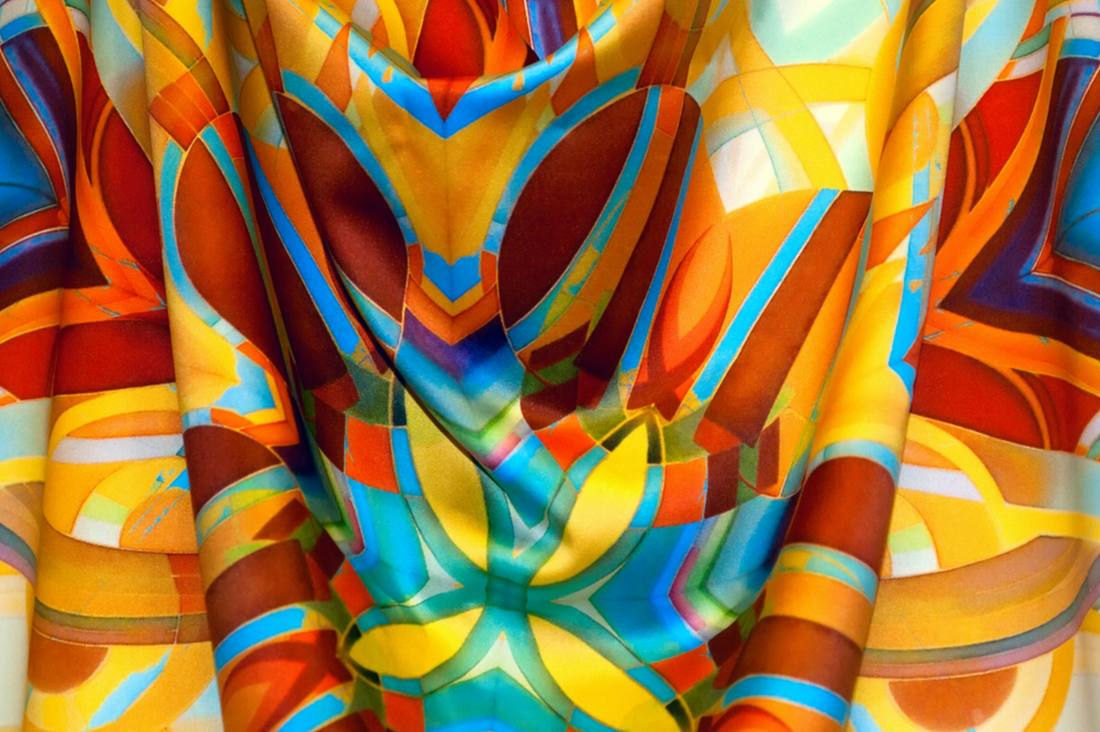It seems these days that design options are endless, but a good editing eye is more important now than ever before. The following tips may be of some help as you consider using printed fabrics this next season.
1. Don't be too hyper-focused on the pixel level detail.
Remember, your costumes and flags are being seen from a distance. DO: Focus on details that translate to the press box or back of the auditorium because those aspects will pay off in dividends with your audiences and judges. Your flag or costume is being appreciated in motion, so consider how that movement will affect how that design is interpreted as it moves.
2. Don't forget the importance of contrast.
You would never choreograph only one level or dynamic into your phrasing, or accept monotone vocals in an arrangement. Use that same design logic when it comes to your costume and flag prints. DO: Arrange opposite elements within a print and notice how your designs read better from a distance. Be warned- without contrast your costumes and flags end up looking bland or unintentionally simplistic, and that might end up being a distraction to an otherwise great idea. We've found a great article that might clarify and inspire you on how you can use contrast in a way that works well for your show.
3. Don't overdesign everything.
Coco Chanel said “Before you leave the house, look in the mirror and take one thing off.” The same could be said for costume and flag designs. Trust us, we love a blinged out and rhinestoned fantasy moment when the occasion calls, but don't get trapped in trying to show off every single nook and cranny of your show theme in one single flag or costume design. Sometimes simplicity just works. DO: Trust your editing eye and remember that sometimes, less is more! You don't want the floor, props, flags, costumes, equipment, AND the performer all competing for attention within the total package.
4. Don't ignore your performance space.
Subtle or soft color choices might work well in a gymnasium, but may not translate the same on a football field during the mid-day sun when shadows are harsh and the bright light washes out most subtle prints. It's great that you love the way your design looks up close or on Instagram with a moody filter, but remember to consider how it will read to your audience IRL (in real life). DO: Take the performance environment into account when you are working on a design. If the majority of your performances are done in an area that experiences very cloudy days with diffused lighting, you might want to consider how to maximize effect with color or print choices that contrast or compliment those gloomy lighting situations so your group stands out in a good way.
5. Don't be afraid of standing out.
While there is a risk in overdesigning your costumes or flags with fussy details that won't translate to your audience, there is also the issue of being underwhelming and not scaling large enough to your performance environment. Don't over-edit things so much that your production looses all sense of character and visual impact. DO: Design boldly when the occasion calls for it! Remember, in order to get a reaction in the first place there has to be a defining visual element that makes people lean forward in their seat and pay attention. Sometimes we project our own fashion or color insecurities on a project, so be careful that those feelings don't put a damper on something that needs to be larger than life in order to work. Color and creativity don't necessarily cost extra, so let your DS Designer help you maximize them both to your program's advantage.
6. Don't assume digital printing is easier.
It would be a huge mistake to assume that because a design relies on printing, versus traditional methods of embellishment, that it is somehow an easier process. The opposite is actually true, despite the perceived simplicity of the garment. DO: Plan accordingly and be aware of how important it is you start the process early when using digital prints. Taking a design from the screen to an actual sewn garment or flag involves a dozen or more skilled artists and production team members communicating together to ensure accuracy of artwork placement, color management, and construction. Just like your printer at home, issues with ink, paper, and troubleshooting mechanical parts all impact the timeline. Factors like humidity, speed, temperature, and fabric tension settings all determine whether or not the print will come out vivid and bright. Keeping track of the thousands of printed pieces is also a massive undertaking. Consider a 6-piece band top for a group that has 200 performers. There are 1,200 unique pieces that must all be printed, inventoried, and sewn together! Very few aspects of this process resemble anything automated, so the finished garment is still very much hand-made and special. Directors and Program Coordinators that stay on top of communication and begin their design consultation early, and that also come with a realistic expectation of what can be achieved, will no doubt have a much better experience from start to finish.
Thank you for trusting Dance Sophisticates to be your partner in producing the best possible garments and flags for your incredible students!

